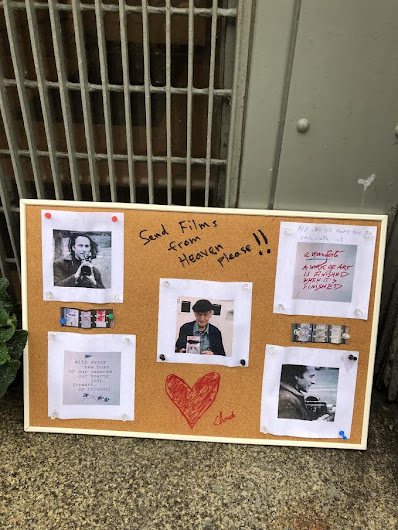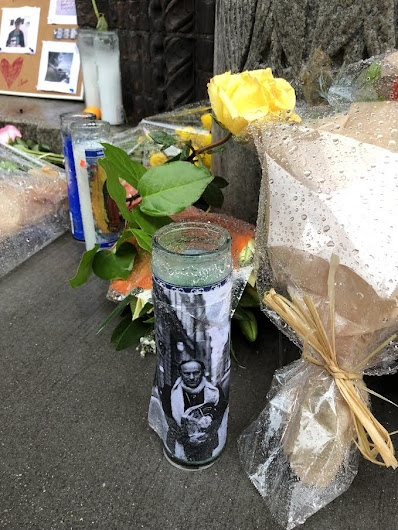
Here's this week's NY See, East Village-based illustrator Grant Shaffer's comic series — an observational sketch diary of things that he sees and hears around the neighborhood ... and NYC.





Choices include popular dishes from Senegal, Guinea, Cote D’Ivoire, Ghana, and Nigeria, and the selection changes daily. The cashier told me, for example, that a fermented cornmeal mash from Ghana called kenkey would be available on Wednesdays ... The day I went, there were several types of rice available, and a Guinean sauce de feuilles made with sweet potato leaves, a Nigerian okra sauce dotted with beef, and a Senegalese chicken yassa ... It helps to know this food already, but you’ll do quite well just loading up your plate with things that look good to you. The cost is $5.99 per pound, which is a great deal.
View this post on InstagramA post shared by Tompkins Square Library (@tompkins_square_library) on
Inspired by The Ronettes, Nirvana, Breeders and Jesus and Mary Chain, Big Joanie have described themselves as being “similar to The Ronettes filtered through ’80s DIY and Riot Grrrl with a sprinkling of dashikis.”

A pop-up show featuring art by:
Peter Bregoli, Jennie Booth, Peter Carey, Marguerite Day, Fred Fleisher, Mark McKinney, Tony Nogueira, and Brad Terhune.
Hours:
Saturday, 2-9 p.m., with an opening reception from 6-9 p.m.
Sunday, noon-8 p.m.




The city has been Mr Harsley’s home since 1948, when, aged ten, he moved there from South Carolina. He took his first photograph ten years later, and became the first black photographer to work for the city’s district attorney’s office. His scintillating pictures freeze moments in New York’s evolution from the 1950s to the present.








“The alternative service plan for the L train hasn’t been completed yet, so citing draft and outdated reports is not only irresponsible but it does a disservice to New Yorkers and our customers who need reliable, official information,” the agency said in a statement. “The MTA will work with the community to provide the service they need while keeping the L train open in both directions 24/7 and providing full, unaltered weekday service for 275,000 riders a day.”













Kalodop’s lawsuit, filed on Tuesday, asks the court to reverse the City Council’s disapproval and enter a judgement approving its ULURP application. It argues that the Landmarks Preservation Commission and the City Planning Commission had already approved their project and attributes community anxiety to “a grass roots campaign of fear and misinformation” from the Merchant’s House Museum that “spurred local community members and representatives into action with a false narrative that any construction at the property would cause the Merchant’s House to be catastrophically damaged.”

The massive building's prolonged vacancy has made the block dark and unsafe, and has encouraged loitering, de Yarza added.
"All the places in the immediate area, they suffer," he said. "It's one of those stretches of 10th Street you don't even want to walk by, and it's a shame."

Born in Lithuania, Mekas first came to New York in 1949 as a refugee; he had been imprisoned by the Nazis, then found himself stateless after the Soviets invaded. Plunging himself into the underground film scene, he became the Village Voice’s first full-time film critic in 1958 ... fervently championing independent and experimental cinema.
Mekas didn’t just write about movies. He made them, he showed them, and it would be fair to say he lived them. Much of his prolific cinematic output was built around footage of his everyday life. (Start with his masterpieces — "Walden,' from 1969; "Reminiscences of a Journey to Lithuania," from 1972; "Lost, Lost, Lost," from 1975; and "As I Was Moving Ahead Occasionally I Saw Glimpses of Beauty," from 2000.)
By founding the Film-Makers’ Cooperative and the Film-Makers’ Cinematheque in the 1960s, he made it possible for underground filmmakers to bypass traditional distribution schemes. The Cinematheque eventually grew into Anthology Film Archives, which continues to be one of New York’s essential screening venues.
But the past tense doesn’t fit Mekas. He still makes films; he still writes, teaches, programs, and champions. This man who worked with Andy Warhol and John Lennon and Lou Reed and Maya Deren might be the least nostalgic person I’ve ever encountered. And he remains more excited than discouraged by what he sees in the world — even when he’s perplexed by it.
Jonas was the guiding force here at Anthology from its founding through to the present day, and even as he reached the age of 96 the idea that he might not be here in person to continue to inspire us has been inconceivable. But Jonas was nothing if not forward thinking, large spirited, and devoted in every fiber of his being to celebrating what is most vibrant in life and culture.
His work as a filmmaker, artist, writer, and archivist (among many other roles) was animated precisely by a powerful, paradoxical balance between a preoccupation with the past and an inexhaustible openness to new ideas, forms, and experiences. What better model for confronting the fact of his passing, for balancing sorrow at his death with a celebration of the vitality of his legacy?
His absence will be difficult to accept, but his spirit will continue to suffuse Anthology, New York City, and avant-garde culture around the world.






In the coming months, we're boosting service by adding 1250 new bikes and 2500 docks in the busiest parts of the system throughout Manhattan & Brooklyn.
— Citi Bike (@CitiBikeNYC) January 22, 2019
Want to learn more? Visit @NYC_DOT for their full presentations on this infill plan: https://t.co/2Q5bwJUfWd



The Ottendorfer Branch of the New York Public Library opened in 1884 as New York City's first free public library. Designed by German-born architect William Schickel, this landmark building combines Queen Anne and neo-Italian Renaissance styles with an exterior ornamented by innovative terracotta putti. The branch was a gift of Oswald Ottendorfer, owner of the New-Yorker Staats-Zeitung newspaper.

The 10th annual "Spiritual Sounds" will be presented on Sunday, Jan. 27, 5-7 p.m. at Town & Village Synagogue, 334 E. 14th St. between First Avenue and Second Avenue.
This group of neighborhood faith leaders (priests, imams, ministers, rabbis, cantors and monks) all serving within a few blocks of each other first gathered to stand up to hate, intolerance, and prejudice, then, growing naturally to know one another personally, enjoy each other’s company, build the trust needed, help and support each other, remain a shining example of NYC’s community of diversity who celebrate together the depth and richness of our many traditions.
The event is free, open to all. No tickets are required.
The faith organizations:
Medina Masjid Mosque
The Second Avenue Church
The Bhakti Center
The Light of Guidance Sufi Center
The Catholic Worker
The Shul of New York
Town & Village Synagogue
Sixth Street Community Synagogue
Middle Collegiate Church
Most Holy Redeemer-Nativity Catholic Church
The Nechung Foundation
Orthodox Cathedral of the Holy Virgin Protection
St. Mary’s American Orthodox Church
St. Mark’s Church-in-the Bowery